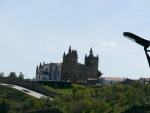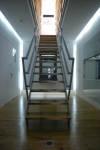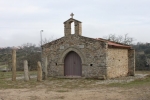DirectoryENG
- BRIDGES AND SIDEWALKS (5)
- CASTLE (6)
- CRUISE
- EMBLAZONED HOUSE (8)
- FOUMTAIN (2)
- HISTORIC BUILDING (6)
- MANOR HOUSE (1)
- PILLORY (14)
- RUINS
- SQUARE (1)
- TRACE RUPESTRES (2)
Date: 16th, 17th and 18th centuries
Description: Ordered by D. João III, king of Portugal, the project begun in the ateliers in the capital, then altered and completed years later by the architect Miguel de Arruda and Spanish masters Francisco Velásquez and Pedro de La Faia. Works began in 1552 and ended in 1566. Until 1780 the cathedral was the center of all social, religious and cultural life in the City of Miranda do Douro. By then the pope decided to reunite the bishopric of Miranda with the city of Bragança. The interior of the temple presents body of three ships divided in five stretches.
The interior of the church is filled by gilded altars and altarpieces, from the national baroque till the beautiful paintings and sculptures of the 16th to 18th centuries. The main chapel was conclude in 1614 by the Spanish master Gregório Fernandez. The prominence goes for a magnificent Calvary of great dramatically tension. The exuberant baroque organ of 18th century still ascends in this magnificent environment of golden cut.
Classification: National Monument, Dec. 16-06-1910, DG 136 de 23 Junho 1910, ZEP, DG 185 de 09 Agosto 1957.
State of Conservation: Very Good
Legends and traditions: The cathedral is known for the legend of Menino Jesus da Cartolinha. The image is of Jesus as a child wearing a top hat and is dated from the late 17th century or early 18th century. The top hat dates from the 19th century. Legend says, that the city was invaded and pillaged by Spanish troops and while the Portuguese troops waited for reinforcements, a little boy very well dressed appeared and called all the inhabitants to rise and fight against the Spanish. People with rustic weapons united and fought the invaders away. During the battle the boy would appear and disappear and after the victory was declared he was never seen again. The little “general” had vanished. People said it had been a miracle and that the victory was due to the little boy Jesus. In his honor, an image of Little Boy Jesus dressed as a noble knight was made and placed on an altar in the cathedral.
Source: http://www.infopedia.pt/$se-catedral-de-miranda-do-douro
Description: Centre of contemporary art, which opened in June 2008, originated from the agreement signed in February 1999 between the cities of Bragança and Zamora.
The center of contemporary art Graça Morais aims to promote awareness and knowledge of national and international contemporary art in general, and the work of the painter Graça Morais, in particular. It is based on a dynamic programme of temporary, collective and individual exhibitions, reinforced by the framework of multidisciplinary initiatives, through the Organization of educational programs that promote, expand, and keep the public interested in contemporary art.
The Art Center also has as objective the creation of a collection of art, from donations, works in deposit or direct purchases. It was designed by the architect Eduardo Souto Moura, winner of the 2011 Pritzker Award (the highest award in the world of architecture).
Description: created for the dissemination of the results of the research conducted in the Lorga Dine, enabling visitors to understand the historical and archaeological importance of the site. Located in Dine 26 km from Vinhais.
Description: A center to receive visitors, of interpretation and a museum, located in the square near the “Pelourinho”.
Description: Responsibility of Palombar – Associação de Proprietários de Pombais Tradicionais (traditional pigeon house owners association), a nonprofit organization whose purpose is to contribute for the recovery, conservation and revitalization of the traditional pigeon houses of northeast region.
Date: Modern Age (the primitive church would be of century XV).
Description: the facade is coated with modern tiles. The vestibule is decorated with sheled form, which opens to a grand window. The interior altars are of polychromatic woodwork.
State of consertation: good
Legends and Traditions: the pilgrimage Senhor de Cabeça Boa occurs in the 1st Sunday of May. Certain day, a Portuguese emigrant in Brazil was lost at sea and asked for the aid the Saint Christ, promising to build a temple to it if he was saved. Thus the chapel of Saint Christ was born, where the arrival of the Christianity to lands of Vera Cruz is celebrated. Other story says that in the darkest night, the lamp suspended in the chapel is sighted in the distant mountain ranges.
Location: Samil, Bragança
Source: Património dos Concelhos da Terra Fria Concelho de Bragança VOLUME II
Dating: 16th century (1509).
Description: Chapel of small proportions. In the chancel are kept some ex-votes of wood with polychrome.
State of conservation: good.
Location: Grijó de Parada, Bragança
Source: Património dos Concelhos da Terra Fria Concelho de Bragança VOLUME II
Dating: 17th century Chapel remodeled in the 18th century
Description: Baroque church consisting of a single ship and rectangular chapel and sacristy. The main façade, of granite, was projected by Damião Bustamante. The main chapel was paved with granite, a presbytery of three steps and a altarpiece with a panel that represents the “Invention of the Santa Cruz”, by Damião Bustamante.
State of Conservation: Very good
Dating: Modern age
Description: Chapel with walls covered with fresh paintings that represent scenes of the Passion of Christ, such as the last Supper, the Calvary and the Crucifixion.
State of conservation: very good
Dating: apparently medieval, was reconstructed in the 90’s (20th century)
Description: Small chapel with vestibule in arc, topped by a tower bell without bell. The interior ship is separate from the mail chapel by a cruise. Before its reconstruction the chapel was abandoned and used as shelter for the animals.










